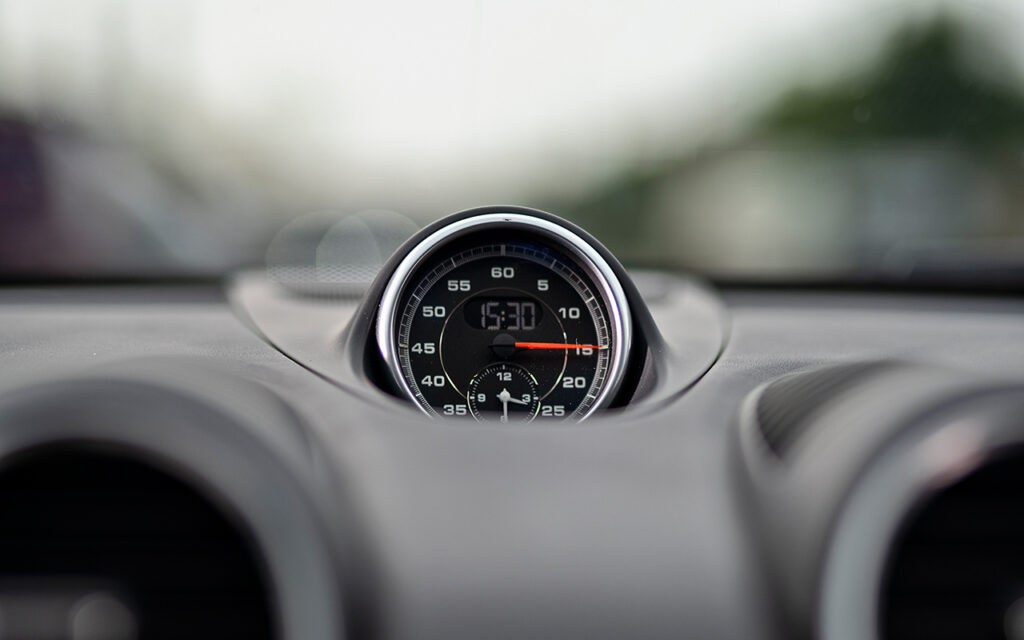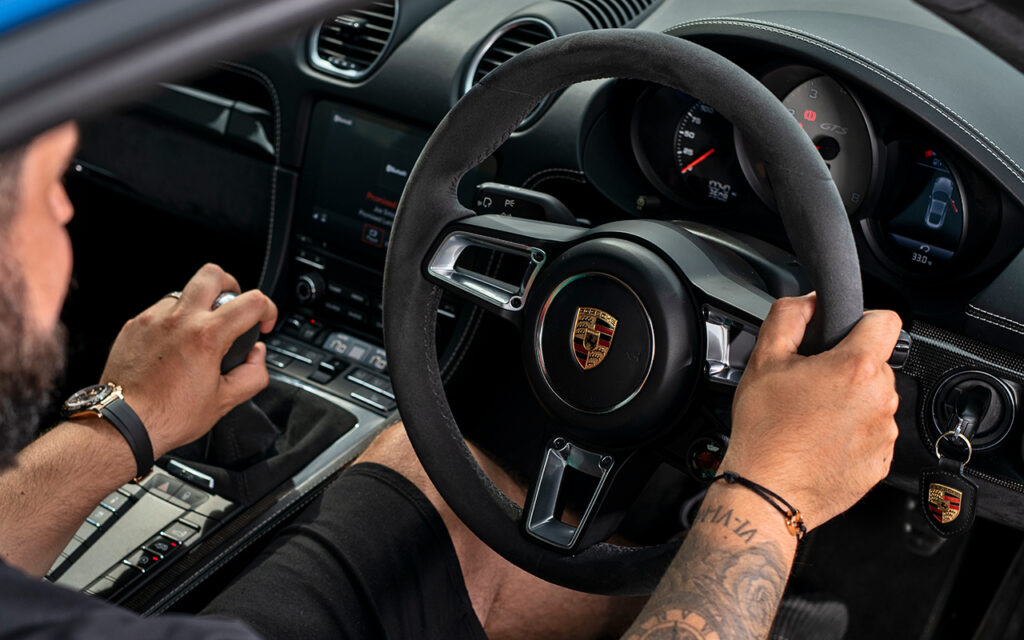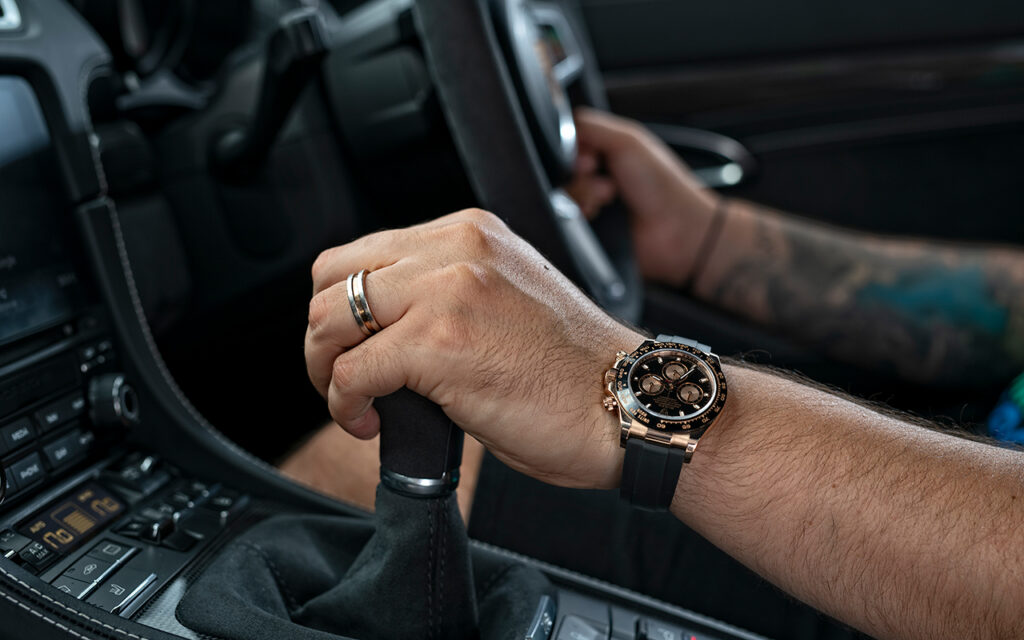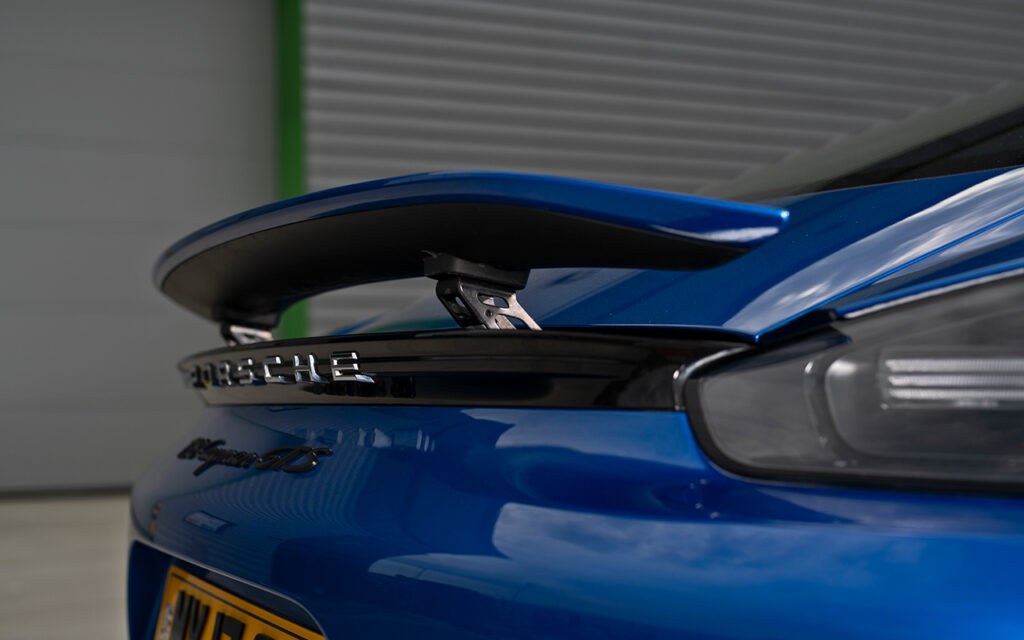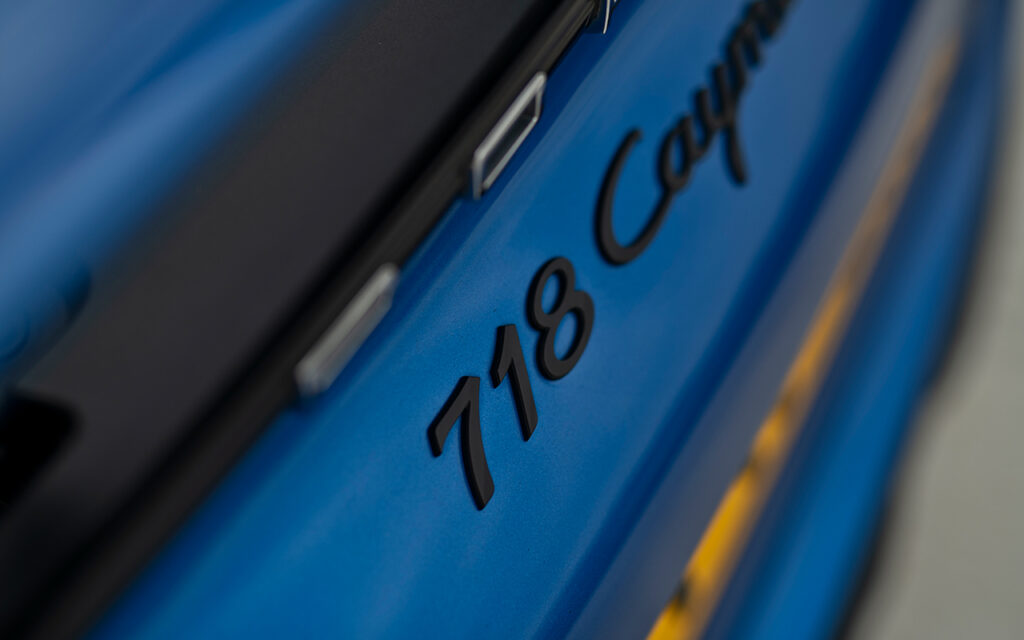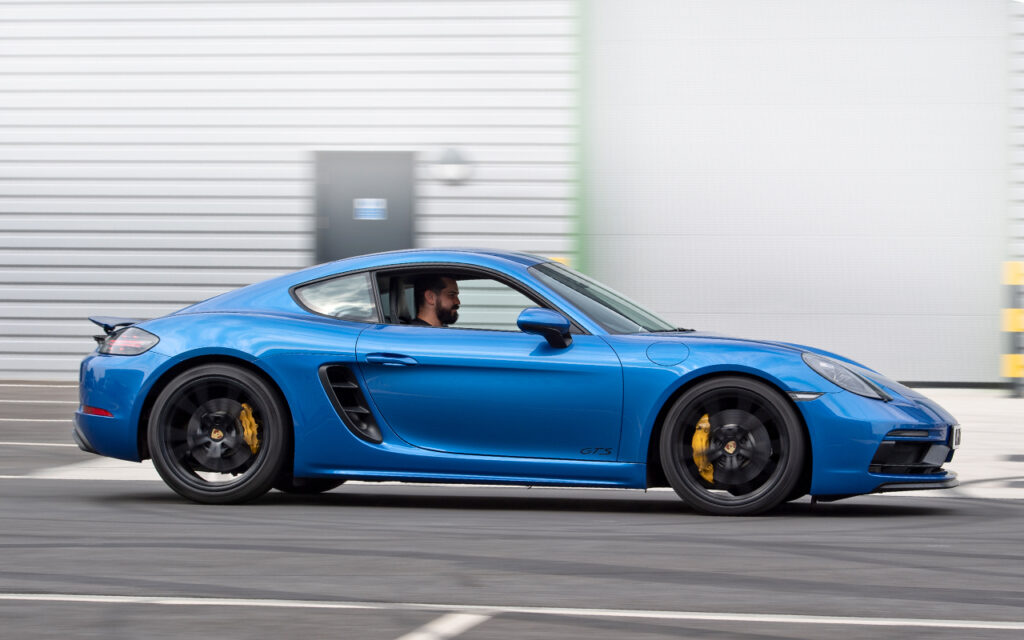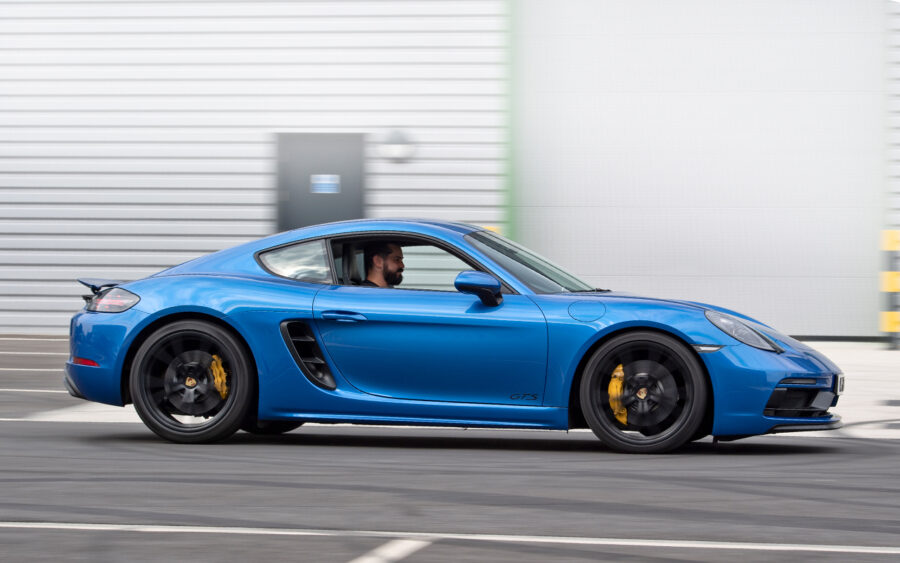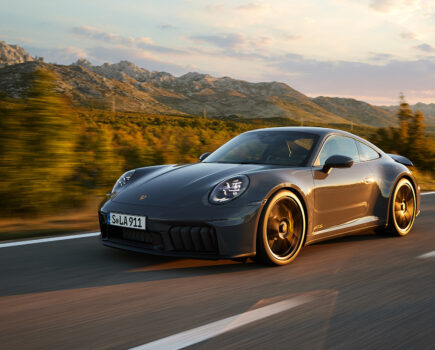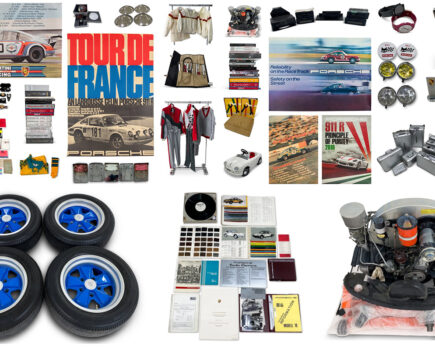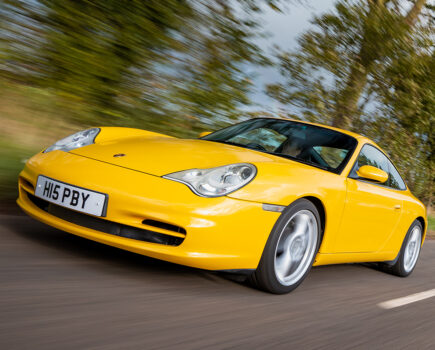The Porsche 718 Cayman GTS is a driver’s delight – despite what some may say about its four-cylinder engine
Words: Dan Furr Images: Jason Dodd
The Porsche 718 Cayman GTS was announced in October 2017. In standard trim, the PDK-equipped GTS can complete the zero to 60mph dash in 3.9 seconds, but the punchy B4-type boxer is a fantastic platform for modifying, and with the earliest cars now out of warranty and the ongoing expiration of original PCP deals, we’re seeing an increasing number of owners experimenting with tuning equipment, recognising the possibility of unleashing big power far easier than if they were toying with a flat-six free of forced induction.
Some people lament the loss of a six-cylinder engine in the 718 Boxster, but it’s likely that many of those people won’t have had a chance to drive one in anger. If you do, it quickly becomes apparent exactly how good Porsche is at making a sports car – regardless of powertrain.
Production of the turbocharged GTS ended in 2019, a response to complaints from Porsche purists demanding the return to a flat-six, but with the 718 Cayman GTS now sitting at a fantastic price point, it’s time to go shopping.

Bodywork
The 718-generation Boxster/Cayman is a significant evolution over the previous 981 range. Obviously, there’s the introduction of all-new four-cylinder turbo engines (see overleaf), but styling was enhanced, too. In fact, only the ‘frunk’, boot lid, windscreen and, in the case of the Boxster, convertible lid are carried over.
In terms of bodywork, these cars are too new for us to comment on any problem areas, but the GTS is a quick, powerful car, meaning it attracts owners and drivers with an excitable appetite for burying the accelerator pedal. Accident damage should be your main concern. Look for differences in colour between panels, check panel gaps, see how badly stone-chipped the front end of the car is. We’ve said it before and we’ll say it again: spend a tenner at mycarcheck.com, where you can download a history report outlining any insurance claims, change of registration number, recorded mileage and whether there is any outstanding finance on the GTS you’re looking at.
You should also enter the vehicle’s details into the DVLA’s online MOT database, a service which will return all passes, failures and advisories registered as far back as records are stored, though there may be nothing to look at if the Cayman you’re looking at is less than three years old (and therefore exempt from MOT testing).
The 981 isn’t exactly soft-looking, but the 718 introduced sharper lines and more aggressive bumpers. Despite being more or less the same size as its predecessor, these changes give the 718 more road presence. We’re not hugely enthusiastic about the look of the side intakes (gloss black would look much better than exposed plastic), but this is a very attractive Porsche. Condensation build-up in lights can be frustrating, as can erratic operation of the rear wing.
Standard exterior colours are White, Racing Yellow, Guards Red and Black, with Colour to Sample available for an additional £6,228. Dynamic headlights (£1,397) and gloss black door handles (£84) were also offered.
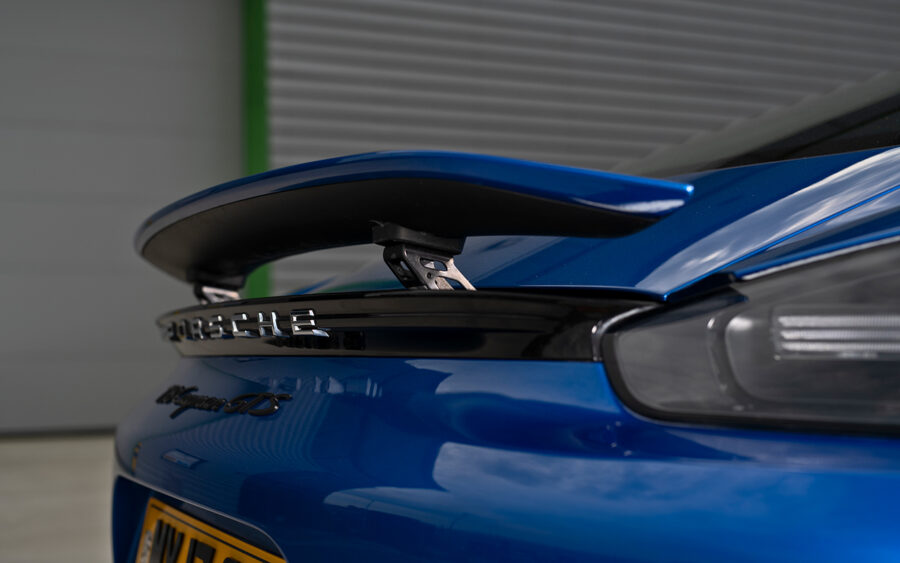
Engine
The B4 flat-four shares a massive number of components with its turbocharged flat-six sibling — you know, the one found in the back of the 911! The list includes the high-pressure direct fuel injection system, the timing chain, almost the entire auxiliary drive, connecting rods and bearings. The flat-four also uses the same technology when it comes to materials and manufacturing of the crankcase and cylinder liners. There are, however, some significant differences.
For example, all 718s make use of adaptive engine mounts, replacing the previous singular forward engine mount with two hydraulic items. As standard, they use engine vacuum to switch between two levels of stiffness, though this can be upgraded to more sophisticated magnetorheological operation through the Sport Chrono Package. By way of a centrifugal pendulum, the 718’s dual-mass flywheel has also been designed to balance out the vibrations of the engine at lower speeds.
The 718’s oil sump is aluminium, while the part is plastic on the 911’s B6 engine, a difference dictated by the former’s hotter exhaust routing. Then, while the variable demand oil pump in the B6 is taken as a basis for that of the flat-four, the smaller engine’s part features two levels of delivery to the B6’s three, reducing the number of components and, consequently, weight.
Porsche went the other way when it came to the control of valves and camshafts, adding sophistication: the flat-four gets VarioCam Plus for complete control of valve timing, as well as two switchable cam profiles for the intake. This is the same as the 911, but in 718 flat-four applications, there’s are also two switchable cam profiles for the exhaust side, allowing calibration to optimise performance or economy, as conditions demand. Nifty stuff.
And what of the engine’s efficiency? Well, when it was launched, Porsche quoted a significant thirteen percent improvement in economy and emissions over what came before. Interestingly, that measurement was given on the old NEDC test regime, which has been shown to vary considerably from real-world conditions. Many miles have been driven in turbocharged four-cylinder 718s since that time and it’s generally accepted the newer powerplant is only marginally more economical than its six-cylinder predecessor when driven in normal traffic. Push on and the flat-four is just as thirsty, though! It’s worth mentioning, however, that despite a weight decrease in the engine department, the 718 models weighed slightly more than their predecessors, chiefly due to added luxury equipment and beefing up of the brakes.

Transmission
The PDK dual-clutch semi-automatic transmission is massively popular with today’s Porsche buyers, and so it proved with the 718 Cayman GTS. The on-paper figures afford PDK owners pub bragging rights, but in the real world, the difference is unnoticeable anywhere other than time trials: with a six-speed manual gearbox managing the GTS’s 317lb-ft torque, 62mph is reached from rest in 4.6 seconds, the time is reduced to 4.3 seconds with the seven-speed PDK unit installed and 4.1 seconds when PDK is paired with active Sport Chrono. And if we’re talking fine margins, a manual-equipped 718 Cayman GTS is only 0.2 seconds slower than a 981 Cayman GT4 (only available with a six-speed stick shift) in the benchmark nought to 60mph sprint test.
Top speed of 180mph is unaffected, no matter the transmission type you choose for your 718 Cayman GT4, though CO2 output is slightly higher when operating the manual: 205 g/km versus PDK’s 186 g/km. You might think this barely deserves a mention, but dropping below 200 g/km allows the PDK car to sit in a lower road tax bracket. Plus, drivers are becoming increasingly concerned with the impact of their carbon footprint. Food for thought, though it’s not likely to sway those of you who are thinking about buying a manual 718 Cayman GTS as a track toy or for an attack of your local B-roads. It’s worth us mentioning PDK attracted a £2,303 cost on the GTS’s Individual Equipment list and comes with the switchable auto/start stop function (including coasting).
Though not a concern for buyers of PDK cars (unless they’ve been driven flat-out downhill), over-revving has been reported on manual-equipped GTSs with overly zealous drivers at the wheel. If possible, and if buying from an independent specialist or main dealer, ask a technician to provide a readout of diagnostic data produced by the factory developed Porsche Integrated Workshop Information System. This will provide you with details of existing and historic fault codes, as well as true mileage.

Suspension, steering and brakes
Four-piston calipers with 330mm (front) and 299mm (rear) rotors are standard equipment, with ceramic discs offered as a cost option for a whopping £5,177. Porsche Torque Vectoring (PTV) with mechanically locking rear differential comes as stock spec, while Porsche Stability Management (PSM), Porsche Active Suspension Management (PASM), a 10mm lowered ride height (20mm was available for an additional £168) and twenty-inch satin black Carrera S wheels also come as standard, the latter wrapped in Michelin 235/35 (front) and 263/35 (rear) N-rated tyres.
Interior and trim
Modern GTS-badged Porsches are designed to be easier to live with on a daily basis than their more hardcore GT4 counterparts, and the 718 Cayman GTS is no exception. Standard interior trim includes two-way electric Sports seats with elevated side bolsters (check for wear where previous owners may have dragged their jeans across the surface), head rests stitched with GTS script, Silver Grey backrest shells, a 360mm GT steering wheel (with optional PDK shift paddles), roof lining and A-pillars trimmed in black Alcantara, Sports pedals, air-conditioning, electric everything and fantastic infotainment equipment: PCM, 4G/LTE compatibility, eight loudspeakers (for a total output of 150W), DAB, CarPlay and Android Auto, to name but a few factory features.
Additional comfort and tech could be introduced with the GTS interior package (£2,096), the amazing Alcantara GTS Package (an extra £1,242), seat heating (£294), ISOFIX child seat mounting points (£126), aluminium pedals (£185), ParkAssist front and rear cameras (£1,086), twin-zone automatic climate control (£539) and cruise control (£228). Adding a high level of extra equipment could take the base price of a 718 Cayman GTS from £60,557 to almost £80k, which is why you should expect to pay a premium for an example kitted-out with these desirable features. Just make sure they all work before parting with your hard-earned cash!
It might only have two seats (let’s face it, the 911’s rear pews are pretty useless, so don’t get too hung up on this aspect of Cayman ownership), but the 718 GTS is surprisingly practical. It shares the same front and rear luggage compartments, door storage pockets and elevated centre console with closed and open cubby holes as the rest of the 718 range, with the classic twin cup holders tucked away above the glovebox. The rear offers 150 litres of space, the front gives an impressive 275 litres to chuck your shopping or trackday gear.
The standard 718 Cayman GTS interior colour is black, but those looking for exclusivity could option Crayon-coloured stitching and matching seat belts when placing the order for their new Porsche.

Porsche 718 Cayman GTS: our verdict
The car pictured here belongs to Aaron Singh – and he’s a big proponent of the oft-maligned four-cylinder Cayman, especially in GTS form. “I’d advise anyone thinking about buying a 718 Cayman GTS to get one without hesitation,” he says. “This car comes hot on the heels of a string of 911s I’ve owned, and I’m bowled over by how good the GTS is. I prefer the mid-engined model’s chassis dynamics over the feel of the 911, and at the track, I can push harder at the limit for longer. Ignore anyone who complains about the noise of a turbocharged flat-four over the growl of a flat-six. Just spend time driving a 2.5-litre GTS and you’ll be won over.”
He’s not wrong. Besides, if you’re inconsolable over the fact a turbocharged four-pot doesn’t sound like a naturally aspirated six-shooter, you could always follow Aaron’s lead and upgrade the GTS’s standard exhaust with an aftermarket system from any one of a number of tuners well aware of the value in producing pipework radically changing the noise from the turbocharged 718’s back end. You’re likely to free a few trapped ponies, too.
